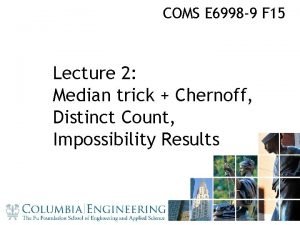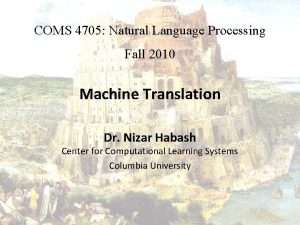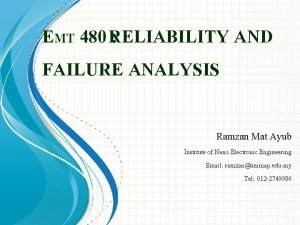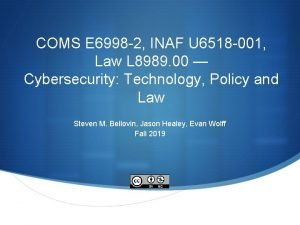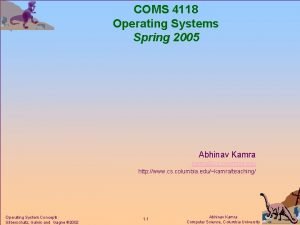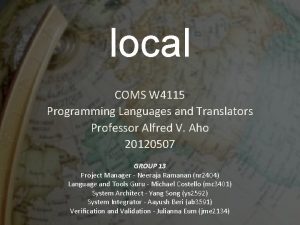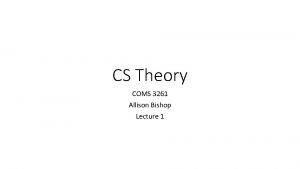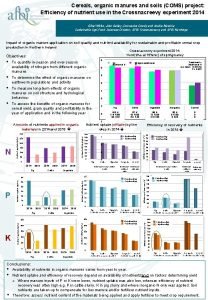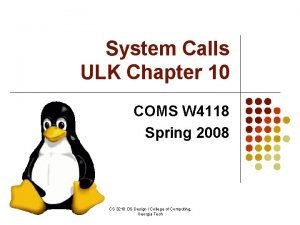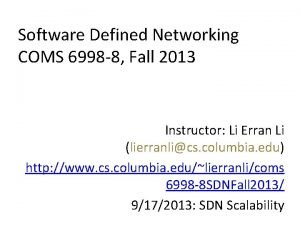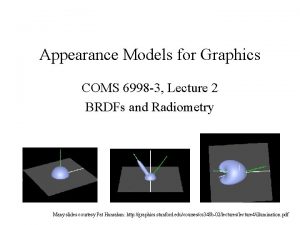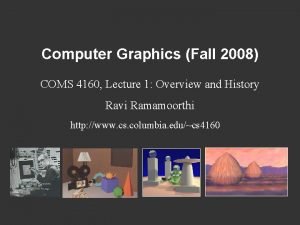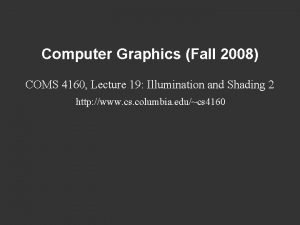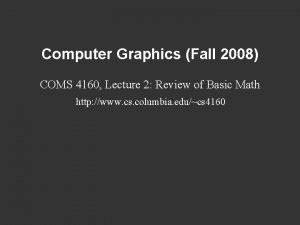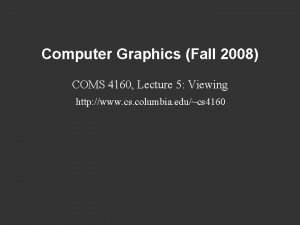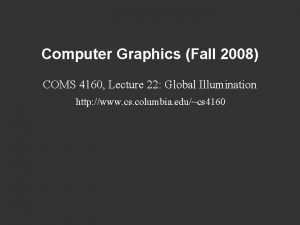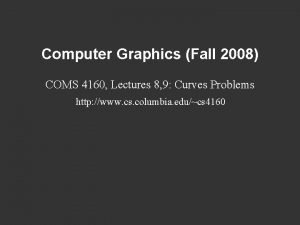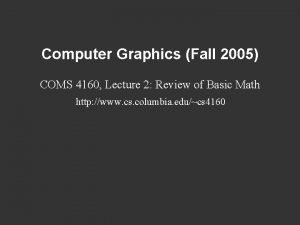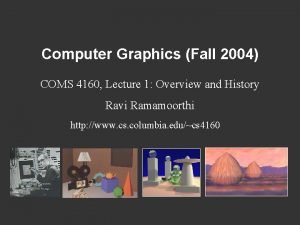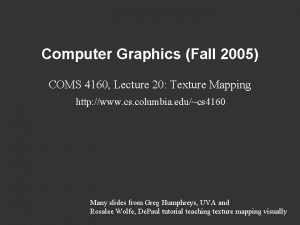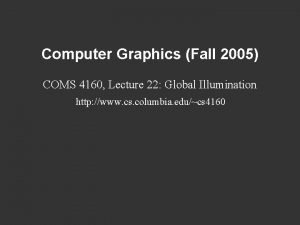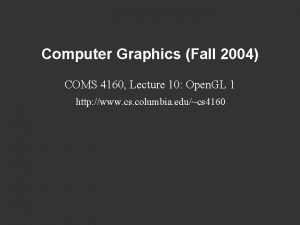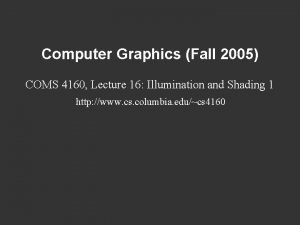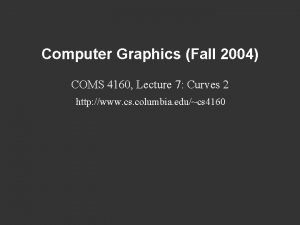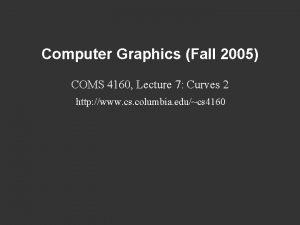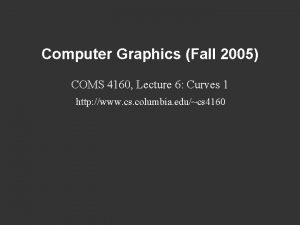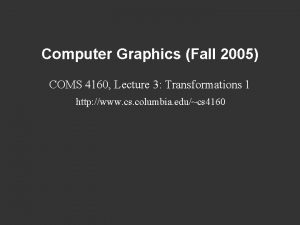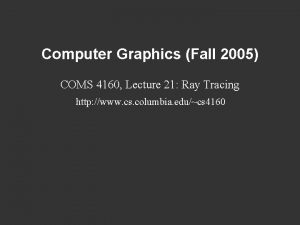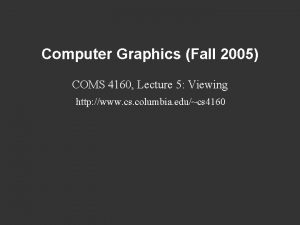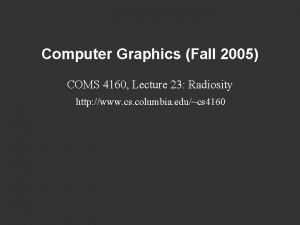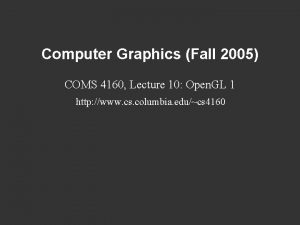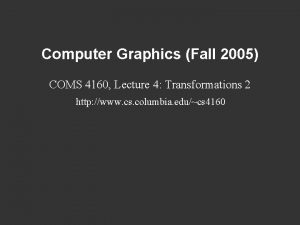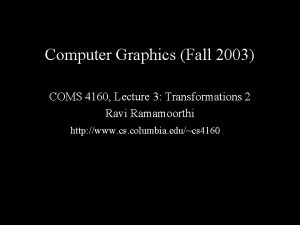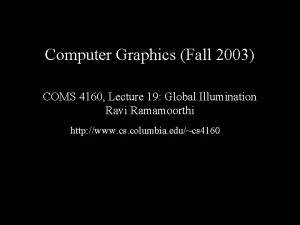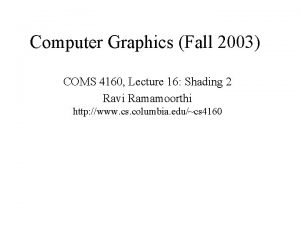Computer Graphics Fall 2008 COMS 4160 Lecture 3










![Rotations 2 D simple, 3 D complicated. [Derivation? Examples? ] 2 D? § Linear Rotations 2 D simple, 3 D complicated. [Derivation? Examples? ] 2 D? § Linear](https://slidetodoc.com/presentation_image_h2/cf80b48386540a14a37a7df491a014f1/image-11.jpg)














- Slides: 25

Computer Graphics (Fall 2008) COMS 4160, Lecture 3: Transformations 1 http: //www. cs. columbia. edu/~cs 4160

To Do § Start (thinking about) assignment 1 § Much of information you need is in this lecture (slides) § Ask TA NOW if compilation problems, visual C++ etc. § Not that much coding [solution is approx. 20 lines, but you may need more to implement basic matrix/vector math], but some thinking and debugging likely involved § Specifics of HW 1 § Axis-angle rotation and glu. Look. At most useful (essential? ). These are not covered in text (look at slides). § You probably only need final results, but try understanding derivations. § Problems in text help understanding material. Usually, we have review sessions per unit, but this one before midterm

Course Outline § 3 D Graphics Pipeline Modeling (Creating 3 D Geometry) Rendering (Creating, shading images from geometry, lighting, materials)

Course Outline § 3 D Graphics Pipeline Modeling (Creating 3 D Geometry) Unit 1: Transformations Resizing and placing objects in the world. Creating perspective images. Weeks 1 and 2 Ass 1 due Sep 25 (Demo) Rendering (Creating, shading images from geometry, lighting, materials)

Motivation § Many different coordinate systems in graphics § World, model, body, arms, … § To relate them, we must transform between them § Also, for modeling objects. I have a teapot, but § Want to place it at correct location in the world § Want to view it from different angles (HW 1) § Want to scale it to make it bigger or smaller

Motivation § Many different coordinate systems in graphics § World, model, body, arms, … § To relate them, we must transform between them § Also, for modeling objects. I have a teapot, but § Want to place it at correct location in the world § Want to view it from different angles (HW 1) § Want to scale it to make it bigger or smaller § This unit is about the math for doing all these things § Represent transformations using matrices and matrix-vector multiplications. § Demo: HW 1, applet transformation_game. jar

General Idea § Object in model coordinates § Transform into world coordinates § Represent points on object as vectors § Multiply by matrices § Demos with applet § Chapter 6 in text. We cover most of it essentially as in the book. Worthwhile (but not essential) to read whole chapter

Outline § 2 D transformations: rotation, scale, shear § Composing transforms § 3 D rotations § Translation: Homogeneous Coordinates (next time) § Transforming Normals (next time)

(Nonuniform) Scale transformation_game. jar

Shear
![Rotations 2 D simple 3 D complicated Derivation Examples 2 D Linear Rotations 2 D simple, 3 D complicated. [Derivation? Examples? ] 2 D? § Linear](https://slidetodoc.com/presentation_image_h2/cf80b48386540a14a37a7df491a014f1/image-11.jpg)
Rotations 2 D simple, 3 D complicated. [Derivation? Examples? ] 2 D? § Linear R(X+Y)=R(X)+R(Y) § Commutative transformation_game. jar

Outline § 2 D transformations: rotation, scale, shear § Composing transforms § 3 D rotations § Translation: Homogeneous Coordinates § Transforming Normals

Composing Transforms § Often want to combine transforms § E. g. first scale by 2, then rotate by 45 degrees § Advantage of matrix formulation: All still a matrix § Not commutative!! Order matters

E. g. Composing rotations, scales transformation_game. jar

Inverting Composite Transforms § Say I want to invert a combination of 3 transforms § Option 1: Find composite matrix, invert § Option 2: Invert each transform and swap order § Obvious from properties of matrices transformation_game. jar

Outline § 2 D transformations: rotation, scale, shear § Composing transforms § 3 D rotations § Translation: Homogeneous Coordinates § Transforming Normals

Rotations Review of 2 D case § Orthogonal? ,

Rotations in 3 D § Rotations about coordinate axes simple § Always linear, orthogonal § Rows/cols orthonormal R(X+Y)=R(X)+R(Y)

Geometric Interpretation 3 D Rotations § Rows of matrix are 3 unit vectors of new coord frame § Can construct rotation matrix from 3 orthonormal vectors

Geometric Interpretation 3 D Rotations § Rows of matrix are 3 unit vectors of new coord frame § Can construct rotation matrix from 3 orthonormal vectors § Effectively, projections of point into new coord frame § New coord frame uvw taken to cartesian components xyz § Inverse or transpose takes xyz cartesian to uvw

Non-Commutativity § Not Commutative (unlike in 2 D)!! § Rotate by x, then y is not same as y then x § Order of applying rotations does matter § Follows from matrix multiplication not commutative § R 1 * R 2 is not the same as R 2 * R 1 § Demo: HW 1, order of right or up will matter § simplest. Glut. exe

Arbitrary rotation formula § Rotate by an angle θ about arbitrary axis a § Not in book. Homework 1: must rotate eye, up direction § Somewhat mathematical derivation (not covered here except relatively vaguely), but useful formula § Problem setup: Rotate vector b by θ about a § Helpful to relate b to X, a to Z, verify does right thing § For HW 1, you probably just need final formula simplest. Glut. exe

Axis-Angle formula § Step 1: b has components parallel to a, perpendicular § Parallel component unchanged (rotating about an axis leaves that axis unchanged after rotation, e. g. rot about z) § Step 2: Define c orthogonal to both a and b § Analogous to defining Y axis § Use cross products and matrix formula for that § Step 3: With respect to the perpendicular comp of b § § Cos θ of it remains unchanged Sin θ of it projects onto vector c Verify this is correct for rotating X about Z Verify this is correct for θ as 0, 90 degrees

Axis-Angle: Putting it together Unchanged Component Perpendicular (cosine) along a (rotated comp) (hence unchanged)

Axis-Angle: Putting it together (x y z) are cartesian components of a
 Graphics monitor and workstation in computer graphics
Graphics monitor and workstation in computer graphics 3d viewing devices in computer graphics ppt
3d viewing devices in computer graphics ppt 2008 2008
2008 2008 01:640:244 lecture notes - lecture 15: plat, idah, farad
01:640:244 lecture notes - lecture 15: plat, idah, farad Coms 6998
Coms 6998 Sambit sahu columbia
Sambit sahu columbia Coms 4705
Coms 4705 Coms 4118
Coms 4118 Coms
Coms Coms 6998
Coms 6998 Abhinav kamra
Abhinav kamra Coms 4115
Coms 4115 Coms 3261
Coms 3261 Coms project
Coms project Coms 4118
Coms 4118 Coms 6998
Coms 6998 Coms 6998
Coms 6998 Computer security 161 cryptocurrency lecture
Computer security 161 cryptocurrency lecture Computer aided drug design lecture notes
Computer aided drug design lecture notes Architecture lecture notes
Architecture lecture notes Computer architecture lecture
Computer architecture lecture Angel computer graphics
Angel computer graphics Types of projection in computer graphics
Types of projection in computer graphics Types of display devices in computer graphics
Types of display devices in computer graphics In two dimensional viewing we have?
In two dimensional viewing we have? Shear transformation in computer graphics
Shear transformation in computer graphics




